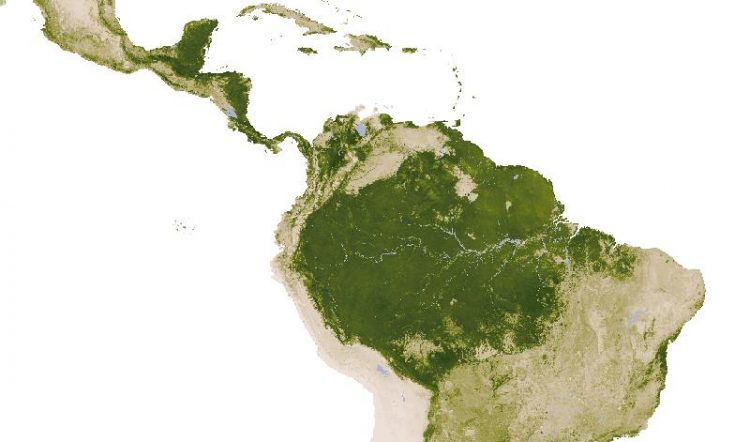Shallow soils promote savannas in South America

Map of vegetation in the Amazon (dark green) and adjoining savanna (light green) as reflected in the Leaf Area Index based on satellite MODIS data. Copyright: NASA Earth Observatory, Robert Simmons
There are models and there is the reality; and in some cases they just don’t match. This is what Liam Langan and his team at the Senckenberg Biodiversity and Climate Centre found when looking at the natural boundary between the lush Amazonian rainforest and the adjoining savanna with sparsely spaced trees, known as the Brazilian Cerrado. Simulation results from computer models and data gained from satellite MODIS on this area don’t agree.
Soils appear to lie at the root of the problem. “That fire and precipitation mediate tropical rainforest and savanna biome boundaries has been established empirically and included in models”, says Langan. Although known to have an impact, soil depth is usually not taken properly into account in computer vegetation models. Instead these models generally assume a constant soil depth of two to three meters globally.
The researchers found however that the probability of observing a rainforest or savanna at a given point in the Amazonas-Cerrado region hinges on a complex interplay of precipitation, fire and tree rooting depth. When precipitation is above ca. 2.500mm annually, the depth to which trees can root weakly affects which vegetation state is observed and rainforest dominates. However, where precipitation is below 2.500 mm annually, both rainforest and savanna are possible.
“If trees have access to a larger volume of soil, this promotes more wooded vegetation whereas shallower rooting, lower precipitation and fire promote less wooded, grass dominated vegetation zones. It’s all about water availability: Access to deeper soil layers typically increases the total amount of soil water available to plants which in turn favors tropical rainforest with its evergreen trees. It doesn’t stop there though, these interactions also alter plant communities composition and diversity”, explains the research group leader Dr. Simon Scheiter, Senckenberg Biodiversity and Climate Research Centre.
This knowledge enables scientists to improve vegetation models and heighten their capability to accurately predict future vegetation changes in these areas. Langan: “This area is about the size of Europe. The Amazonian rainforest is a biodiversity hotspot and one of the world’s major carbon stores. Predicting how this area’s vegetation might respond to changing conditions is by no means trivial. More accurately modelling how constraints on plant rooting influence vegetation formations will help elucidate how this area will respond to climate change.”
Contact
Liam Langan
Senckenberg Biodiversity and Climate Research Centre
Phone +49 (0)69 7542 1864
Liam.langan@senckenberg.de
Dr. Simon Scheiter
Senckenberg Biodiversity and Climate Research Centre
Phone +49 (0)69 97075 1617
simon.scheiter@senckenberg.de
Sabine Wendler
Press officer
Senckenberg Biodiversity and Climate Research Centre
Phone +49 (0)69 7542 1818
Sabine.wendler@senckenberg.de
Publication
Langan, L., Higgins, S. I. and Scheiter, S. (2017): Climate-biomes, pedo-biomes or pyro-biomes: which world view explains the tropical forest–savanna boundary in South America?. Journal of Biogeography. doi:10.1111/jbi.13018
To study and understand nature with its limitless diversity of living creatures and to preserve and manage it in a sustainable fashion as the basis of life for future generations – this has been the goal of the Senckenberg Gesellschaft für Naturforschung (Senckenberg Nature Research Society) for 200 years. This integrative “geobiodiversity research” and the dissemination of research and science are among Senckenberg’s main tasks. Three nature museums in Frankfurt, Görlitz and Dresden display the diversity of life and the earth’s development over millions of years. The Senckenberg Nature Research Society is a member of the Leibniz Association. The Senckenberg Nature Museum in Frankfurt am Main is supported by the City of Frankfurt am Main as well as numerous other partners.
Additional information can be found at www.senckenberg.de
200 years of Senckenberg! 2017 marks Senckenberg’s anniversary year. For 200 years, the society, which was founded in 1817, has dedicated itself to nature research with curiosity, passion and involvement. Senckenberg will celebrate its 200-year success story with a colorful program consisting of numerous events, specially designed exhibitions and a grand museum party in the fall. Of course, the program also involves the presentation of current research and future projects.
Additional information can be found at: www.200jahresenckenberg
Media Contact
More Information:
http://www.senckenberg.deAll latest news from the category: Earth Sciences
Earth Sciences (also referred to as Geosciences), which deals with basic issues surrounding our planet, plays a vital role in the area of energy and raw materials supply.
Earth Sciences comprises subjects such as geology, geography, geological informatics, paleontology, mineralogy, petrography, crystallography, geophysics, geodesy, glaciology, cartography, photogrammetry, meteorology and seismology, early-warning systems, earthquake research and polar research.
Newest articles

Bringing bio-inspired robots to life
Nebraska researcher Eric Markvicka gets NSF CAREER Award to pursue manufacture of novel materials for soft robotics and stretchable electronics. Engineers are increasingly eager to develop robots that mimic the…

Bella moths use poison to attract mates
Scientists are closer to finding out how. Pyrrolizidine alkaloids are as bitter and toxic as they are hard to pronounce. They’re produced by several different types of plants and are…

AI tool creates ‘synthetic’ images of cells
…for enhanced microscopy analysis. Observing individual cells through microscopes can reveal a range of important cell biological phenomena that frequently play a role in human diseases, but the process of…





















